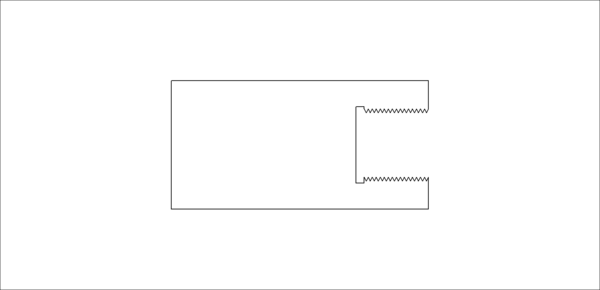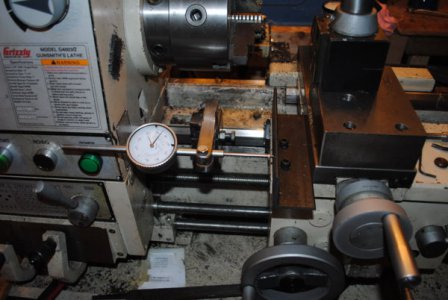Hey all, I have a project I am doing were I need to internal thread into a blind hole. I was thinking about trying to thread it away from the chuck, but my chuck is threaded on and I am worried about it spinning off. Is this a bad idea to try and do? Anyone have any other way of threading it? Thanks all for your help!
-
Welcome back Guest! Did you know you can mentor other members here at H-M? If not, please check out our Relaunch of Hobby Machinist Mentoring Program!
You are using an out of date browser. It may not display this or other websites correctly.
You should upgrade or use an alternative browser.
You should upgrade or use an alternative browser.
Internal threading away from the chuck
- Thread starter Armourer
- Start date
- Joined
- Dec 22, 2015
- Messages
- 561
I did that on my 10 x 22 lathe and it has a threaded chuck, BUT it also has locking clips that prevent the chuck from unthreading. I got away with it but I only took light cuts. One time the chuck did try to come off but thankfully the locks stopped it. I would not try it unless your lathe has some kind of chuck locking device.
I'm relatively new to this stuff and others with more experience will likely chime in with a solution for you.
I'm relatively new to this stuff and others with more experience will likely chime in with a solution for you.
- Joined
- Jan 16, 2020
- Messages
- 8
Here is what I do when possible:

- Machine the bore just a bit deeper than it needs to be - .125" to .250" - This dimension depends on the size of your project.
- Cut a relief channel about .125" wide and just a bit deeper than the major diameter of the thread. It should be located at a depth that allows the length of thread that you desire.
- Machine your thread as normal. The relief channel gives you a 'safe zone' in which to stop the travel of the carriage without crashing the tool into the bottom of the bore.

- Joined
- Jan 16, 2017
- Messages
- 216
I've done it already on a Le Blonde lathe. I wasn't taking heavy cuts....I think the important thing is to take light cuts and see if anything changes. When you go slow and take deep cuts, that's when it wants to un-thread.
- Joined
- Jul 2, 2014
- Messages
- 7,594
In addition to what Terry said, you can move the tool to the bottom of the hole and then wrap the boring bar with masking tape even with the end of the hole. That lets you see very clearly how far you are away from crashing. You can also cheat and have a foot brake like I do, which stops the spindle in less than one revolution. Still, lately I have been threading internal holes outward instead of inward. Much safer, less stress.Here is what I do when possible:
Here is a cutaway view of a sample part:
- Machine the bore just a bit deeper than it needs to be - .125" to .250" - This dimension depends on the size of your project.
- Cut a relief channel about .125" wide and just a bit deeper than the major diameter of the thread. It should be located at a depth that allows the length of thread that you desire.
- Machine your thread as normal. The relief channel gives you a 'safe zone' in which to stop the travel of the carriage without crashing the tool into the bottom of the bore.
View attachment 253336
- Joined
- Apr 28, 2014
- Messages
- 3,590
Oh, what I wouldn't give to have a brake on my 1440 after my half-nut mechanism malfunction.In addition to what Terry said, you can move the tool to the bottom of the hole and then wrap the boring bar with masking tape even with the end of the hole. That lets you see very clearly how far you are away from crashing. You can also cheat and have a foot brake like I do, which stops the spindle in less than one revolution. Still, lately I have been threading internal holes outward instead of inward. Much safer, less stress.
I'm attempting to do everything left to right in order to reduce the stress and you mention.
Thanks for the replies! I think I will try and thread into the chuck, I was worried about not seeing were to stop the cutter but I just finished boring the hole out and I will see no problem. Now my next problem, figuring out to make the relief cut at the bottom of the hole....
- Joined
- Jul 2, 2014
- Messages
- 7,594
Make something like this from HSS, or buy one:Thanks for the replies! I think I will try and thread into the chuck, I was worried about not seeing were to stop the cutter but I just finished boring the hole out and I will see no problem. Now my next problem, figuring out to make the relief cut at the bottom of the hole....
http://internaltool.com/products/lathe/79/thread-relief-tools

- Joined
- Dec 20, 2012
- Messages
- 9,422
Make something like this from HSS, or buy one:
http://internaltool.com/products/lathe/79/thread-relief-tools
View attachment 253346
As Bob said, I use these on most blind internal holes and thread toward the chuck. Micro 100 sells these in solid carbide and you can often find them for good prices on ebay. To be fair, my lathe has a clutch on the drive shaft and I also use a carriage stop, just in case, so I don't hesitate to thread toward the chuck.
- Joined
- Apr 8, 2013
- Messages
- 1,979
I made a carriage stop/dial indicator holder for my Grizzly G4003G. When boring or threading a hole to specific depth I kill the power .050" from the shoulder and turn the chuck with a piece of 3/8 key stock right to the shoulder. The lathe will coast to about 20 thou of the shoulder before it stops. I use a 2" DI on the long feed and a 1" on the cross.



